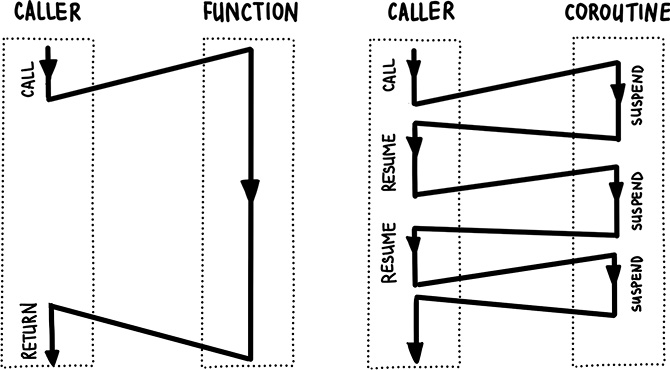Coroutine Scope 공유 문제
- 쿠버네티스 Pod Kafka 컨슈머의 Bean 생성 실패 현상
- Coroutine Scope 공유로 인한 이벤트 간 상호 취소 문제 해결 경험

⇒ 같은 scope내에서 비동기적인 실행 (= caller) 코드로 예시를 들면
@Test
fun `코루틴`() {
runBlocking {
launch {
delay(1000L)
println("World!")
}
println("Hello,")
}
}
//결과
Hello, World!

runBlocking 으로 감싸여진 launch{} 와 println("Hello, ") 는 같은 scope에 있다.launch로 생성된 코루틴은 비동기 실행이 가능
launch가 실행되고 내부에서delay(1000L)가 걸리면 코루틴이므로 해당 블록을 빠져나와 println("Hello, ")를 실행한다.println("World!") 를 실행한다.-> 코루틴인 launch{} 는 블록이 실행 중에도 같은 스코프 내에서 다른것들과 협력한다!
코루틴은 기본적으로 세가지로 구성되어있다.
CoroutineScope, GlobalScope , ..Dispatcher.IO, Dispatcher.Main, Dispatcher.Default, ...job과 Dispatcher
async, launch, runBlockingCoroutineScope에서 코루틴이 생성되어야만 비동기적인 동작을 한다. await() 메서드가 수행되면 코루틴의 결과가 반환되기까지 기다림 runBlocking은 현재의 스레드를 점유한다라는것이다.
CoroutineScope(Dispatchers.IO).launch { } 이런식으로 사용launch { } 이렇게 더 많이 사용한다.
세가지 기본 구성에 추가로 dispatcher와 suspend fun, withContext에 대해 설명
종류는 기본적으로 네가지가 있다.
#### Dispatcher.Default
sysctl -n hw.ncpu
# 결과
8
repeat(50) {
CoroutineScope(Dispatchers.Default).launch {
println(Thread.currentThread().name)
}
}```
#### `Dispatcher.IO`
- **Default Dispatcher와 스레드풀을 공유**
- 필요에 따라 스레드를 더 생성하거나 줄일수 있다. (최대 64개)
- 이름에 맞게 주로 **DB, 네트워크, 파일 관련 작업에 적합**
- 위의 방법과 동일하게 thread를 출력해보면 **core의 개수보다 많은것**을 확인할수있다.
- 그 이유는 대기시간이 긴 네트워크 작업의 경우 **더 많은 스레드를 이용해 병렬처리**하는것이 더 효율적이기 때문이다.
#### 프로젝트에 적용시에는 기본적으로 제공하는 Dispatcher를 사용하기보다 각 기능에 맞는 Dispatcher를 생성해 사용하는것이 좋다.
예시)
, WebClient 통신시..)
- suspend fun 만으로는 비동기 처리 X
- suspend fun은 코루틴 내부에 있어야하고, 그 코루틴은 해당 스코프에서 비동기 처리를함
- 비동기에서 중요한점은 **해당 스코프에서 코루틴을 생성**해야한다는 것이다.
- coroutine의 suspend 함수는 thread를 block 하지않는다.
<br/>
헷갈렸던 부분을 예시로 들어보면
<br/>
``` kotlin
@Test
fun `동기`() {
runBlocking {
val time = measureTimeMillis {
val one = first()
println("between")
val two = second()
println("the answer is ${one + two}")
}
println("Completed in $time ms")
}
}
suspend fun first(): Int {
println("first")
delay(1000L)
println("first end")
return 13
}
suspend fun second(): Int {
println("second")
delay(1000L)
println("second end")
return 29
}
나의 착각
runBlocking)에서 suspend fun 을 호출하므로 비동기적으로 실행될것으로 착각했다.runBlocking 밖에 없다.
first
first end
between
second
second end
the answer is 42
Completed in 2021 ms //비동기 처리 안됨
**코루틴을 생성하지않고 위와같은 방식으로 사용시 비동기 동작이 안된다는것을 알수있다. **
async로 묶는다.async { first() }, println("between"), async { second() } 가 있고
aync 로 만들어진 코루틴은 협력하는 함수 이므로 특정 시점(delay)에 일시정지를 하고 코루틴을 빠져나와 같은 스코프의 다른 함수들과 협력할수있다.@Test
fun `비동기`() {
runBlocking {
val time = System.currentTimeMillis()
val one = async { first() }
println("between")
val two = async { second() }
println("the answer is ${one.await() + two.await()}")
println("Completed in ${System.currentTimeMillis() - time} ms")
}
}
suspend fun first(): Int {
println("first")
delay(1000L)
println("first end")
return 13
}
suspend fun second(): Int {
println("second")
delay(1000L)
println("second end")
return 29
}
between
first
second
first end
second end
the answer is 42
Completed in 1018 ms // 비동기 처리
그림으로 나타내보면 아래와 같다.

println("first") 보다 println("between") 이 먼저 출력된것은 async를 call 하기 때문이다.withContext는 블록의 마지막 줄 값을 반환한다.withContext의 블록이 끝나기전까지 해당 코루틴은 일시정지
coroutineScope와의 차이점은 withContext는 컨텍스트를 전달할수있다.
coroutineScope ≡ withContext(this.coroutineContext)주문 도메인에서 사용하고 있는transactionTemplate.executeWithContext {}를 살펴보자
이것은 withContext이므로 코루틴 빌더가 아니다. (처음엔 이것도 코루틴 빌더라 착각했다.)
트랜잭션을 만들고 그 동작을 설정한 context에서 한다 라는 의미이다.
실제로 구현된 코드를 보면

execute 하는 것을 볼수있다.boundedElasticDispatcher를 사용

첫 학습 시 코루틴에 대해 확실히 이해하기 어려웠는데 아래 자료를 많이 참고함 https://silica.io/understanding-kotlin-coroutines/5/
코루틴을 이해하기 위해 먼저 멀티 스레드가 아닌 단일 스레드에서 진행하면서 코루틴을 이해하고 이후 예시에서 멀티 스레드를 다루겠다.
(현재 스레드 의 출력하는 부분은 코드상 생략)

[Test worker] Starting a coroutine block... // [Thread 종류 @코루틴번호] 출력,
[Test worker @coroutine#1] Coroutine block started // 현재는 싱글 스레드에서 실행하므로 test worker에서만 실행
[Test worker @coroutine#1] Two coroutines have been launched
[Test worker @coroutine#2] 1/ First coroutine start
[Test worker @coroutine#3] 2/ Second coroutine start
[Test worker @coroutine#3] 2/ Second coroutine end
[Test worker @coroutine#2] 1/ First coroutine end
[Test worker] Back from the coroutine block
'Two coroutine have been launched' 가 1/ First 와 2/ Second 보다 왜 먼저 출력될까?

launch를 call을 한다.
println("Two coroutines have been launched") 가 먼저 실행된것
코드 예시
 결과
결과
First coroutine start, suspend for 50ms
Second coroutine start, suspend for 100ms
First coroutine : starting some computation for 100ms
Computation ended
Second coroutine end after 160ms // 100ms 가 아닌 160ms 가 소요됨

Thread.sleep(100) 으로 스레드를 독점함 (delay와 달리 thread가 blocking된다.)
Webclient 같은 non-Blocking 작업에 효과적이지만, Blocking 방식의 RDBMS 작업은 효과적이지 않다 라는 결론.멀티 스레딩 방식의 코루틴을 사용 해야한다.
Dispatcher를 이용하면 스레드를 변경할수있다.코드 예시

Dispatchers.Default : Default worker 스레드풀을 사용한다.
Test worker만을 사용해 단일 스레드로 비동기 처리를 했음================== 첫번째 ==================
[Test worker] #0 Starting a coroutine block
[DefaultDispatcher-worker-1 @coroutine#1] #0 Coroutine block started
[DefaultDispatcher-worker-2 @coroutine#2] #0 First coroutine started
[DefaultDispatcher-worker-3 @coroutine#3] #0 Second coroutine started
[DefaultDispatcher-worker-3 @coroutine#3] #0 Second coroutine end
[DefaultDispatcher-worker-2 @coroutine#2] #0 First coroutine end
[Test worker] #0 Back from the coroutine block in thread [Test worker] after 133ms // 150ms 보다 작음
================== 두번째 ==================
[Test worker] #1 Starting a coroutine block
[DefaultDispatcher-worker-2 @coroutine#4] #1 Coroutine block started
[DefaultDispatcher-worker-2 @coroutine#6] #1 Second coroutine started
[DefaultDispatcher-worker-1 @coroutine#5] #1 First coroutine started
[DefaultDispatcher-worker-2 @coroutine#6] #1 Second coroutine end
[DefaultDispatcher-worker-1 @coroutine#5] #1 First coroutine end
[Test worker] #1 Back from the coroutine block in thread [Test worker] after 106ms // 150ms 보다 작음

Thread.sleep을 총 100 + 50 = 150ms 를 했지만 실제 결과들은 그것보다 짧음
DefaultDispatcher를 이용해 다른 스레드들(worker-2, worker-3)에서 각각 100ms, 50ms 작업을 했기때문이다.defaultDispatcher-worker 스레드 풀을 생성 비용 때문코드 예제
 결과
결과
[Test worker] Starting a coroutine block
[DefaultDispatcher-worker-1 @coroutine#1] Coroutine block
[DefaultDispatcher-worker-2 @coroutine#2] First coroutine started
[DefaultDispatcher-worker-3 @coroutine#3] Second coroutine started in thread
[DefaultDispatcher-worker-3 @coroutine#3] Second coroutine end
[AccessThread @coroutine#4] Second coroutine reporting result=13 in Access Thread
[DefaultDispatcher-worker-2 @coroutine#2] First coroutine end
[AccessThread @coroutine#5] First coroutine reporting result=29 in Access Thread
[Test worker] Back from the coroutine block

accessContext 라는 하나의 스레드에서 리소스에 접근한다.newSingleThreadContext() 만 사용하면된다.withContext를 사용하면 된다.
launch(accessContext) => withContext(accessContext)
직접 그려본 다이어그램